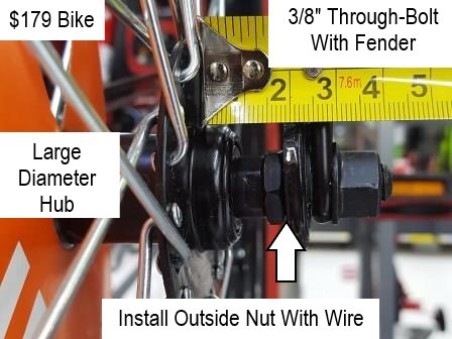FAQ - README
Will it fit?
Top speed:
The manufacturer of the counter specifies the unit should not exceed 5,000 counts per minute, which equates to 27kph, or 17 mph on 700c x 35 tires, and slower on 26” tires. Many people have exceeded this briefly during routine riding without incident, however the limit exists, and failures have occurred. In one case, the user admitted to routinely exceeding 35 mph on a long downhill.
Lubrication / maintenance:
If there is any resistance to turning, first examine the setup. If there is resistance or excessive noise during operation, something is binding. Try a little spray silicone lubricant. - it's possible that this will seek out the binding and smooth out the operation.
Noise:
Properly installed it does make a little noise, but sometimes prior to failure it sounds louder. It’s likely the unit was bent laying the bike down, or otherwise catching the counter on something loading or riding the bike. Possibly it’s getting worn out. In normal operation there should be little noise, and no “grinding” sound. Oil is often the cure for noise.
Be careful:
If you recognize the sound it makes is “different”, check to make sure the unit spins freely and the gears aren’t binding. If the gears mesh too tightly, you may have bent the chassis slightly. I’ve bent a couple straight, usually a slight tug on the counter is all it takes to get the gears to mesh properly again.
Can it be reset?
The counter does not have a reset button. Over the years Jones Counters have never had them. The counter is part of the measurement process, and the process includes review by a state certifier. Having people reset their count in the middle of a measurement, unless fully explained, can lead to confusion. Thus no great demand for a resettable counter has yet arisen.
What kind of bike should I use??
Almost any kind of bicycle can be used to measure . Calibration constants for "Fat tires" vary due to temperature more than "skinny tires", and various solid tires have been studied. If you intend to measure a number of courses, you may consider acquiring a separate bicycle with optimal measuring characteristics. These are presented in no particular order of importance.
- The bicycle should be easy to mount. One necessary skill that you will need to master is starting up with as little "wobble" as possible. I find a bicycle that is a little small is easier to mount than one that is a little large. You will spend a considerable amount of time standing astride the bicycle taking notes.
- I like to use tires on the higher end of the pressure range, 80 psi or so. There is no data to support the idea that better measurements are obtained with higher pressures. (See Mike Sandford's study, it's interesting)
- Consider puncture-resistant tire inserts on the front tire. Nothing is worse than getting a flat during measuring, as all the days effort is wasted.
- The seat should be comfortable. Most of the time you will be riding "a mile", stopping to take data, and riding further. Measuring a marathon will take some time in the saddle.
- You will need to carry a few items with you, and should consider a handlebar bag. Also, a separate water-bottle carrier is handy to carry spray-paint. Many other adaptations have been used and some can be entertaining.
- It is likely you will get some paint on your tires eventually. I would advise against using a costly bicycle.
- The bicycle should be geared to your terrain. Hopefully the course is not so steep that climbing the hills is difficult, but if you are in hilly terrain a road-bike may not have a good "granny gear".
Why is there so much "slop" in the gears?
The clearance and gear engagement was studied closely during development. After thousands and thousands of miles of wear the hole at the center of the large gear will eventually get larger. The extra "play" in the gears accounts for movement, and allows for rotational forces to be tranferred to the counter shaft tangentially. To date not one black gear has worn out. It works, and it is simple.
Why the goofy 26/11 gear ratio? Wouldn't 1:20 be "better"?
NO!
- The gear ratio is based on fundamental gear design priciples. Having larger prime numbers incorporated into the geartrain minimizes wear on the teeth. Any particular tooth on one gear will only touch a particular tooth on the other gear once in 143 revolutions.
- The precision obtained is also slightly higher, giving 23.6363 counts per tire revolution.

